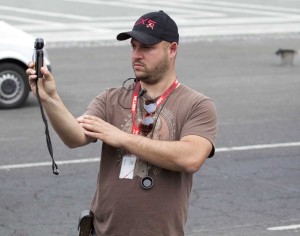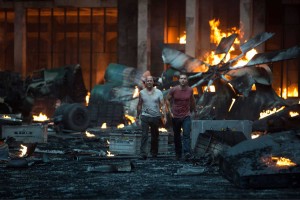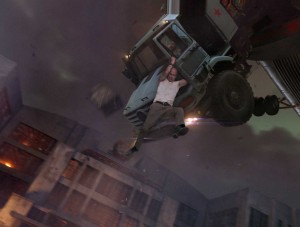
Director of photography Jonathan Sela is no stranger to action movies. But his work on A Good Day to Die Hard was his “most complex challenge yet” as a cinematographer, because of the logistics of lensing an ongoing series of over-the-top sequences.
The film stars Bruce Willis as John McClain and is the fifth in the iconic series that began 25 years ago with the original Die Hard. It comes replete with dangerous stunts, screeching car chases, machine gun shootouts and multiple fireball explosions that were mostly created with traditional non-CGI effects and filmed in camera. It also stars newcomer Jai Courtney as McClain’s estranged miscreant son Jack, who to his father’s surprise, is working undercover to free a high-value whistleblower in Russia. The two end up teaming on the assignment.

This was Sela’s third consecutive film with director John Moore. Previously he was DP on Moore’s helming of The Omen (2006), a remake of the horror classic, and on Max Payne (2008), starring Mark Wahlberg and Mila Kunis. For the look of A Good Day to Die Hard, “John wanted Moscow to seem like a sink of corruption and that led to the camerawork being frenetic and handheld and to the gritty, desaturated color scheme,” said the cinematographer.
Sela shot with a film camera, not digitally. “We had an initial conversation and both he and I decided we wanted texture,” he said. “We wanted grain which you get with film. John is a much more traditional filmmaker. And we had so many cameras shooting at the same time, we didn’t want to be tethered with a lot of cables. We wanted to put the camera on the shoulder and go where we wanted go. All of that would have made a digital workflow much harder.”
 The director and Sela also preferred “to do as much as possible in camera.” So filming the numerous fiery explosions and especially the spectacular finale which involves the world’s largest helicopter, a Russian Mi:26, slicing into a building and setting off an enormous fireball, required meticulous advance preparation.
The director and Sela also preferred “to do as much as possible in camera.” So filming the numerous fiery explosions and especially the spectacular finale which involves the world’s largest helicopter, a Russian Mi:26, slicing into a building and setting off an enormous fireball, required meticulous advance preparation.
“It was like assembling a 3000-piece jigsaw puzzle,” said the DP. “There were so many variables we really had to break it down one step at a time, piece by piece.” The detailed prep required many meetings between the DP, the production designer and the visual effects supervisor. “We had to test everything, every car flip – we bought a lot of old cars – and also anything that involved explosions we had to test for safety and to make sure they would not be too small or too big. You don’t want to ruin a whole day and have to do it all over again.”
Many scenes were shot on enormous studio sets, requiring deft illumination. “Lighting keeps me going every day,” Sela said. “That’s my passion. I enjoy creating different moods, playing with colors or with shadows.”
The Israeli cinematographer learned lighting at an early age, first in theater and then in movies. At age 10, his Polish grandfather took him to the set of Schindler’s List in Krakow, inspiring him to pursue a career in filmmaking. He began his career at age 14, when he joined crews making Israeli television shows and then films, beginning as a lighting technician and later moving up to gaffer. He came to the United States when he was 19, enrolling in AFI’s film school in Los Angeles. He served an assistant to award-winning DP Vilmos Zsigmond on two movies, before getting his first feature assignment as 2nd unit DP on Winter Break. He has also worked on numerous commercials and music videos.





